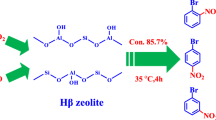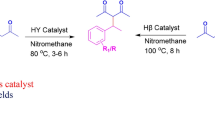Abstract
Beta-zeolite supported ruthenium catalysts for reductive amination of 5-hydroxymethyl-2-furaldehyde (HMF) with an aqueous solution of ammonia (NH3 aq.) and molecular hydrogen (H2) are examined to synthesize the corresponding primary amine of 5-aminomethyl-2-furylmethanol (FAA). Various SiO2/Al2O3 (Si/2Al) ratios of the beta-zeolite support were used to prepare the Ru-based catalysts. It was observed that the Si/2Al ratio was contributed to the catalytic activity, and the Si/2Al = 150 of beta-zeolite was found to be the most active for Ru catalyzed reductive amination of HMF, affording ca. 70% yield. Characterization techniques were taken to analysis the factors that influence the reactivity of catalysts, and which revealed that not only the ruthenium nanoparticle size but also the ratio of RuO2 against metallic Ru species were crucial factors for the reactivity of reductive amination of HMF to FAA.
Graphical Abstract








Similar content being viewed by others
References
Asif M, Muneer T (2007) Energy supply, its demand and security issues for developed and emerging economies. Renew Sustain Energy Rev 11:1388–1413
Nielsen TD, Hasselbalch J, Holmberg K, Stripple J (2020) Politics and the plastic crisis: a review throughout the plastic life cycle. Wires Energy Environ 9:e360
Huber G, Iborra S, Corma A (2006) Synthesis of transportation fuels from biomass: chemistry, catalysts, and engineering. Chem Rev 106:4044–4098
Alonso D, Wettstein S, Dumesic J (2012) Bimetallic catalysts for upgrading of biomass to fuels and chemicals. Chem Soc Rev 41:8075–8098
De Clercq R, Dusselier M, Sels BF (2017) Heterogeneous catalysis for bio-based polyester monomers from cellulosic biomass: advances, challenges and prospects. Green Chem 19:5012–5040
Balat M, Günhan A (2005) Biomass energy in the world, use of biomass and potential trends. Energy Sour 27:931–940
Li G, Hou B, Wang A, Xin X, Cong Y, Wang X, Li N, Zhang T (2019) Making JP-10 superfuel affordable with a lignocellulosic platform compound. Angew Chem Int Ed 58:12154–12158
van Putten R-J, van der Waal JC, de Jong E, Rasrendra CB, Heeres HJ, de Vries JG (2013) Hydroxymethylfurfural, a versatile platform chemical made from renewable resources. Chem Rev 113:1499–1597
Hayes KS (2001) Industrial processes for manufacturing amines. Appl Catal A 221:187–195
Du Y-D, Chen B-H, Shu W (2021) Direct access to primary amines from alkenes by selective metal-free hydroamination. Angew Chem Int Ed 60:9875–9880
Shimizu K, Kon K, Onodera W, Yamazaki H, Kondo JN (2013) Heterogeneous Ni catalysts for N-alkylation of amines with alcohols. ACS Catal 3:112–117
Tripathi RP, Verma SS, Pandey J, Tiwari VK (2008) Recent development on catalytic reductive amination and applications. Curr Org Chem 12:1093–1115
Liang G, Wang A, Li L, Xu G, Yan N, Zhang T (2017) Production of primary amines by reductive amination of biomass-derived aldehydes/ketones. Angew Chem 129:3096–3100
Nakamura Y, Kon K, Touchy AS, Shimizu KI, Ueda W (2015) Selective synthesis of primary amines by reductive amination of ketones with ammonia over supported Pt catalysts. ChemCatChem 46:921–924
Kim J, Kim HJ, Chang S (2013) Synthetic uses of ammonia in transition-metal catalysis. Eur J Org Chem 2013:3201–3213
Gomez S, Peters JA, Maschmeyer T (2002) The reductive amination of aldehydes and ketones and the hydrogenation of nitriles: mechanistic aspects and selectivity control. Adv Synth Catal 344:1037–1057
Rodriguez JA, Liu P, Hrbek J, Evans J, Pérez M (2007) Water gas shift reaction on Cu and Au nanoparticles supported on CeO2(111) and ZnO(0001¯): intrinsic activity and importance of support interactions. Angew Chem Int Ed 46:1329–1332
Komanoya T, Kinemura T, Kita Y, Kamata K, Hara M (2017) Electronic effect of ruthenium nanoparticles on efficient reductive amination of carbonyl compounds. J Am Chem Soc 139:11493–11499
Kanbara S, Kitano M, Inoue Y, Yokoyama T, Hara M, Hosono H (2015) Mechanism switching of ammonia synthesis over Ru-loaded electride catalyst at metal–insulator transition. J Am Chem Soc 137:14517–14524
Dong C, Wang H, Du H, Peng J, Cai Y, Guo S, Zhang J, Samart C, Ding M (2020) Ru/HZSM-5 as an efficient and recyclable catalyst for reductive amination of furfural to furfurylamine. Mol Catal 482:110755
Dong C, Wu Y, Wang H, Peng J, Li Y, Samart C, Ding M (2021) Facile and efficient synthesis of primary amines via reductive amination over a Ni/Al2O3 catalyst. ACS Sustain Chem Eng 9:7318–7327
Liu Y, Zhou K, Meng L, Wang L, Wei Z, Li X (2015) Acidic/basic oxides-supported cobalt catalysts for one-pot synthesis of isophorone diamine from hydroamination of isophorone nitrile. Ind Eng Chem Res 54:9124–9132
Bäumler C, Bauer C, Kempe R (2020) The synthesis of primary amines through reductive amination employing an iron catalyst. ChemSusChem 13:3110–3114
Chary KRV, Seela KK, Naresh D, Ramakanth P (2008) Characterization and reductive amination of cyclohexanol and cyclohexanone over Cu/ZrO2 catalysts. Catal Commun 9:75–81
Xie C, Song J, Hua M, Hu Y, Huang X, Wu H, Yang G, Han B (2020) Ambient-temperature synthesis of primary amines via reductive amination of carbonyl compounds. ACS Catal 10:7763–7772
Valden M, Lai X, Goodman DW (1998) Onset of catalytic activity of gold clusters on titania with the appearance of nonmetallic properties. Science 281:1647–1650
Deelen TV, Mejía CH, de Jong KP (2019) Control of metal-support interactions in heterogeneous catalysts to enhance activity and selectivity. Nat Catal 2:955–970
Nishimura S, Shibata A (2019) Hydroxymethylation of furfural to HMF with aqueous formaldehyde over zeolite beta catalyst. Catalysts 9:314
Richmond HH, Myers GS, Wright GF (1948) The reaction between formaldehyde and ammonia. J Am Chem Soc 70:3659–3664
Nishimura S, Shibata A, Ebitani K (2018) Direct hydroxymethylation of furaldehydes with aqueous formaldehyde over a reusable sulfuric functionalized resin catalyst. ACS Omega 3:5988–5993
Acknowledgements
This study was supported by JSPS-KAKENHI for Young Scientists (A) (Grant No. 17H04966), Japan, and Shibuya Science Culture and Sports Foundation 2020, Ishikawa, Japan. The authors appreciate Dr. Junya Ohyama (Kumamoto Univ.) and Dr. Hiroyuki Asakura (Kyoto Univ.) for their support at XAFS measurement in the SPring-8. The HAADF-STEM was supported by Koichi Higasimine and Shoko Kobayashi (Center for Nano Materials and Technology, JAIST). Ru-K edge XAFS analysis at a BL07 in Saga-LS (Proposal No. 1910092R) is also performed for this study during research progress (not shown).
Author information
Authors and Affiliations
Corresponding author
Additional information
Publisher's Note
Springer Nature remains neutral with regard to jurisdictional claims in published maps and institutional affiliations.
Supplementary Information
Below is the link to the electronic supplementary material.
Rights and permissions
About this article
Cite this article
Li, X., Le, S.D. & Nishimura, S. Reductive Amination of 5-Hydroxymethyl-2-furaldehyde Over Beta Zeolite-Supported Ruthenium Catalyst. Catal Lett 152, 2860–2868 (2022). https://doi.org/10.1007/s10562-021-03872-6
Received:
Accepted:
Published:
Issue Date:
DOI: https://doi.org/10.1007/s10562-021-03872-6




